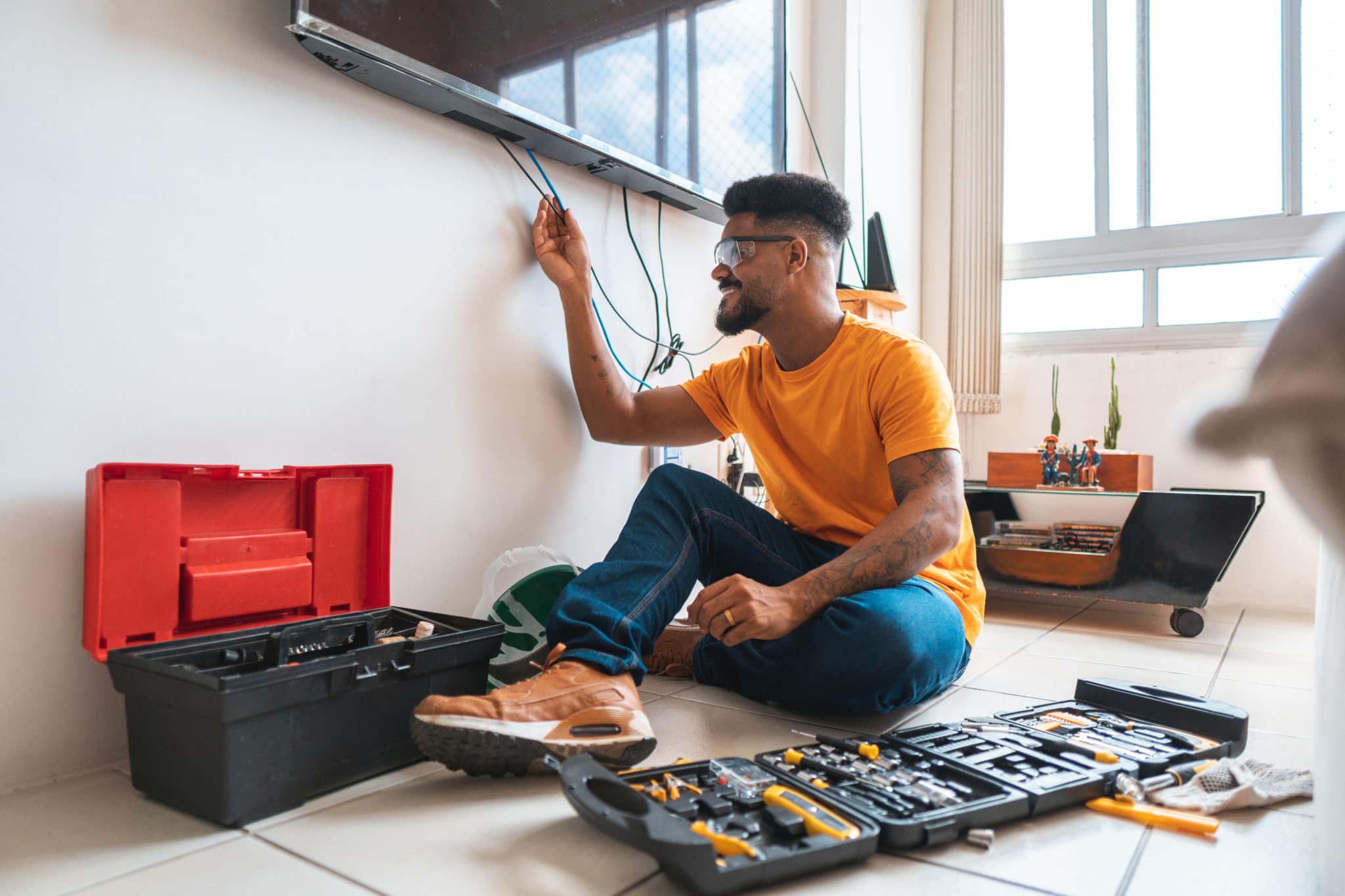Getting rid of old tech and upgrading to a shiny, new flat-screen TV is one step in making your living space more comfortable and modern. Choosing how to mount a TV on the wall is the first thing you’ll want to do after bringing your new purchase home. A wall mount opens up living space, enhances your line of sight, and elevates your room to a new level.
Whatever mount style you choose, here’s a step-by-step guide on how to mount a TV securely and firmly to your wall studs.
Step 1: Pick a Spot for Your New TV
You’ll need to do some planning to figure out where you want to mount your flat-screen TV. As tempting as it may be, don’t skip this step.
Preplanning will prevent you from mounting the TV, stepping back, realizing you don’t like where it is, taking it down, and remounting it again. It also saves you from making unnecessary and unsightly holes in your walls.
The best place to mount your TV is one with good lines of sight. Choose a spot where you’ll still have a decent view no matter how you rearrange your furniture.
You’ll also need to choose a space with easy access. For instance, you may need to connect a:
- Cable box
- Selection of cable inputs
- DVD player
- Gaming console
You’ll also need to consider the location of power outlets and how you’ll hook up auxiliary components like this Creative Stage 2.1 High-Performance Under-Monitor Soundbar with Subwoofer.
Step 2: Choose Your Mounting Bracket
Before you do anything, you’ll need to choose a wall mount. There are four popular kinds of mounts available.
1. Stationary Mounts
A stationary mount TV bracket like the ECHOGEAR Low Profile Fixed TV Wall Mount rests flush against your wall. You can use it to secure your TV in a fixed position.
2. Corner Mounts
A corner mount bracket, such as the Kanto Telescoping Corner TV Mount, allows the TV screen to pivot left and right, allowing you to adjust the viewing angle. This motion accommodates viewing in various parts of the room.
3. Tilting Mounts
A tilting TV mount enables you to angle your screen up and down for better viewing. For instance, the SANUS Tilting TV Wall Mount is excellent if you want to mount your TV high on the wall.
4. Full-Motion Mounts
A full-motion swivel mount bracket, like the Mount-It! Full Motion Swivel Bracket TV Wall Mount, combines the features of the previously mentioned mounts. It enables you to adjust your TV to the perfect viewing angle for anywhere in a room—some even have telescoping arms.
For these instructions, we’re assuming you have a stationary mount. These kinds of mounts come with two essential parts, a:
- Mounting bracket that you drill into your wall
- Mounting plate that you affix to the back of your TV
Just know that some of the other kinds of TV mounts may come with different parts that require more steps.
Step 3: Find the Studs
The studs in your home do an excellent job of supporting your TV. Wall anchors don’t provide as much support as using screws to install the TV mount directly to your studs, especially if your TV is heavy. So, the next step in how to mount a TV is finding your wall studs.
- After choosing where to install your TV, use a stud finder—like the Zircon Stud Sensor e50—to find the beams behind the wall.
- Once you’ve found the studs, hold up the wall bracket to align with the studs, and trace the holes with a pencil. This doesn’t have to be perfectly straight yet, as you’re just testing the location. Levels and accuracy will come next.
- Now, test your pilot hole locations with a nail to make sure that you’ve located the studs accurately.
If possible, you want to install both sides of the mount using the studs in the framing of your wall. Try to avoid using hollow wall anchors if possible.
Step 4: Install the Wall Mount on the Studs
Now that you’re sure you’ve found studs, you can install the mounting bracket on the wall. You’ll need a level to make sure that you install the mounting bracket perfectly horizontally. The Johnson 9” Magnetic Billet Torpedo Level is a straightforward choice. It’s a good idea to enlist a helper to hold the bracket while you’re taking measurements and making the drill marks.
There’s an old saying that goes, “Measure twice. Cut once.” This saying has endured the test of time for a good reason. A lot of small things can go awry and skew your measurements in the blink of an eye, so always double-check your measurements before you drill holes. Once you’re sure you’ve measured correctly, you can drill the pilot holes and install the wall mount.
Step 5: Install the Mounting Plate on Your Television
Now, you’re ready to install the mounting plate on your television. Varying flat TV mounts have different installation processes. It’s critical to refer to the manufacturer’s instructions on how to mount a TV using their product.
After installing the TV mounting plate, you’re ready to mount your TV on the wall. It’s a good idea to get help with this part, too. You (and preferably a partner) only need to lift the TV onto the wall mount and secure the fasteners, usually by hand, that prevent the plate moving on the wall mount.
Again, for safety’s sake, double-check that you’ve followed the manufacturer’s instructions accurately before moving forward to this final installation step.
Step 6: Wrap Up the Installation
Now, check your work. Give your television a gentle tug to make sure that it’s installed securely.
Of course, you did an excellent job, but assume that there’s a good chance the mounting bracket will come loose when you give the TV a tug. This way, you’re prepared to catch the weight of your TV if it comes loose.
Also, double-check the connection between the wall plate and the TV plate to ensure that it’s secure. Finally, you can install a cord cover, like the Le Grand 30-inch Flat Screen TV Cord Cover, if you want to hide your television cables.
What To Do When Your Studs Don’t Align With the Mounting Bracket
Again, whenever possible, you want to avoid using drywall anchors for installations that must bear considerable weight, like your TV. Yet, you may have no other alternative.
Builders may have framed your studs either 12- or 24-inches apart or in some other configuration. Depending on the size of your mount and the space available, you may not have studs available for both sides of the installation.
If you must use drywall anchors, choose high-load units like SNAPTOGGLE Heavy-Duty Toggle Bolts. And if you can at a minimum, you should attach at least one side of the mount to a stud. Also, make sure that you use a drywall anchor or toggle bolt that’s rated for a sufficient load to support your television.
On rare occasions, you may have zero access to the studs. This kind of installation can prove tricky. Technically, heavy-duty drywall anchors or toggle anchors (also called Molly bolts) can support up to 100 pounds.
With this kind of installation, however, you should also consider the condition of your walls. Do a feel test to see if your walls feel like they can hold the weight of your TV. If you feel movement or other issues, you’ll want to choose an alternative way to mount your flat TV, such as the WALI ELECTRIC TV Ceiling Mount.
Mounting brackets are a fantastic way to better use your space and give your flat-screen TV an even sleeker look. Always take care to find the right location and follow the manufacturer’s instructions when mounting your TV. By following their instructions along with this guide, you can achieve a TV set up that you’ll enjoy for years to come.






